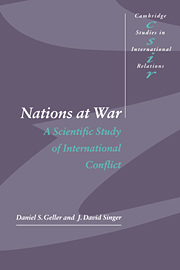Book contents
- Frontmatter
- Contents
- List of figures and tables
- Acknowledgements
- Introduction
- 1 Overview
- 2 Decision models
- 3 War-prone states
- 4 War-prone dyads
- 5 War-prone regions
- 6 War-prone systems
- 7 Case study: Iran/Iraq War (1980)
- 8 Case study: World War I (1914)
- 9 Conclusion
- Appendix 1 List of databases
- Appendix 2 Tables of references by category
- References
- Index
- Cambridge Studies in International Relations
5 - War-prone regions
Published online by Cambridge University Press: 16 October 2009
- Frontmatter
- Contents
- List of figures and tables
- Acknowledgements
- Introduction
- 1 Overview
- 2 Decision models
- 3 War-prone states
- 4 War-prone dyads
- 5 War-prone regions
- 6 War-prone systems
- 7 Case study: Iran/Iraq War (1980)
- 8 Case study: World War I (1914)
- 9 Conclusion
- Appendix 1 List of databases
- Appendix 2 Tables of references by category
- References
- Index
- Cambridge Studies in International Relations
Summary
Introduction
While the analysis of political patterns as they appear within geographical regions is well established in the fields of comparative and international politics, the majority of these area studies tend to be methodologically subjective and impressionistic. Relatively little quantitative empirical research has been conducted with the purpose of exploring cross-regional variation in patterns of conflict and war.
This chapter examines data-based research on war-prone regions (references listed in appendix 2, table A.3). The initial section of the chapter focuses on simple comparisons between geographic regions in terms of the frequency of crises, subwar disputes, and wars, as well as inter-regional comparisons of processes of militarized dispute contagion. The second section explores evidence relating to intra-regional patterns of conflict and war that may be dependent upon spatial heterogeneity, population pressure, polarity, and normative constraints. The third section of the chapter examines evidence of war contagion as it pertains to patterns of intra-regional conflict behavior. Both spatial and temporal distances are incorporated as factors in a possible contagion process. The final section examines evidence of intra-regional cycles of war. Although there is some overlap with Europe-centered theories of cycles in global warfare, evidence relating specifically to more narrowly defined regional conflicts is the primary focus here. The majority of data-based studies on war cycles, contagion /diffusion processes, polarity, and norms is conducted at the systemic level of analysis and will be discussed in chapter 6.
- Type
- Chapter
- Information
- Nations at WarA Scientific Study of International Conflict, pp. 97 - 112Publisher: Cambridge University PressPrint publication year: 1998

